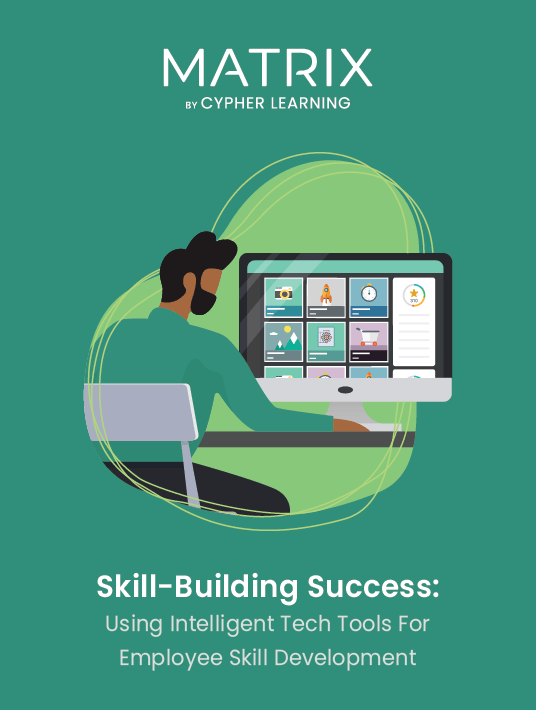Why Investing In A Skills Development Program Is Worth The Time And Money
Corporate training expenditure in the US grew by almost 10 billion in 2021 [1], reaching 92.3 billion. Employers spend on average $1,270 per worker's training [2]. How can your company allocate this budget wisely to benefit from training ROI?
Determining the most significant employee training costs before launching a skills development program is essential. So is finding the right tools to create and implement such programs. Explore four main training costs and solutions to minimize them and streamline the entire training process.
Investing in a skill development program makes sense today more than ever. Most employees dread dead-end jobs. According to a 2021 report by Monster [3], 45 percent of employees are more likely to stay in their current jobs if their companies offer more training. The same survey shows that 2% of employees leave their current jobs because they don’t offer sufficient growth opportunities.
Investing in adequate skills development training ensures your most valuable employees stay longer in your company and contribute to its growth, and also helps you attract new talent. Moreover, skills development ROI becomes visible when your workforce keeps up with the everchanging demands of today’s digitally-shaped work environment. Reskilling and upskilling programs offer workers the knowledge they need to meet new requirements in their current and future roles.

Skills Development Training Costs To Consider
Planning Costs
An effective skills development program requires careful planning. It all starts with finding the right training objectives that align with your organization’s needs and your employees’ career goals. This initial stage of the training process might already require a share of your training budget.
You might have an internal L&D department that can plan, design, and implement training for your employees. If you don’t, you must factor in the costs of hiring training specialists and subject matter experts who can offer guidance in designing the right skills development program and implementing it.
They can help you establish your short- and long-term goals, and align them with your organization’s operational and financial objectives and culture. In the planning stage, you must also determine the type of training your employees need.
Whether it’s an upskilling or reskilling program, ensure you spot the current skills gaps you aim to narrow and anticipate those that might appear further down the line. Research shows that 74% of hiring managers say there is a skills gap in the current labor market [4]. Skills development training is crucial to closing it and prioritizing learning as part of a sound employee growth and retention strategy.
Training Software
Organizations allocate approximately 16% of their budget to training technology [5]. This investment must help you maximize your training ROI. Therefore, the training tools and tech you choose should have skills development features at their very core to help you create, deliver, and track training programs’ results with ease.
Whether your development program focuses on technical, digital, or soft skills, to ensure a lean training process, the technology you rely on should have features such as:
- Goal-related features that make it easy to set, track, and achieve training objectives
- Personalized content recommendations tailored to learners’ skills and goals
- Adaptive learning features and customized learning paths based on trainees’ progress
- Gamification and collaboration tools that increase engagement and reward employees
- Feedback features to show learners if they’re on the right track via instant results
- Automation features to put enrolments, notifications, or assessments on autopilot
- Mobile compatibility to engage learners in their training via their smartphones
- Mentorship tools for experienced employees to help peers achieve their training goals
Having all these features in a single platform streamlines training and minimizes the costs and time required by using several tools to create skills development programs.
Besides a training platform, based on your training needs, you might also need to invest in additional software, such as design or authoring tools, to create your content. Add those costs to your expense sheet as you move from the planning stage to choosing your training tech.
Content And Course Development Costs
Content is key to an efficient corporate training program. Regardless of your training goals, it should be relevant, engaging, and easy to follow. To develop such content, you need more than subject matter experts. You must have different design and authoring tools, or even better, a solution that incorporates all the features you need to craft diversified training content, including video and audio materials, as well as different types of automated assessments.
If you want to outsource the content creation process, estimate the costs. Corporate training videos can cost anywhere between $300 – $2000 per minute [6] depending on how complex the video is and what effects it must contain.
To minimize your training expenses while offering trainees a variety of learning resources, you can use a mix of in-house and third-party content. This blend is easy to achieve with a training platform that automatically fetches different types of content from the Internet, such as articles, videos, studies, and third-party courses.
You can also rely on third-party content alone if you’re on a limited budget. Udemy, Linkedin, Skillshare, and plenty of other providers offer a variety of content you could use to equip your employees with new skills. With 29% of training budgets going toward creating or buying content [5], it’s essential to find the most cost-effective and comprehensive solution based on your possibilities and needs.
Course development costs are another expense to consider. These will be tailored to the type of skills development program you want to implement. Options range from instructor-led to remote, individual, or blended training. You can also split your content into smaller microlearning units and enable learners to access them at any time from any device.
Switching from traditional, instructor-led training to remote, self-paced learning can help you cut training costs. For example, Cisco reduced training costs by 60% by adopting e-learning instead of traditional classroom training.
Personalized training that focuses on the individual’s needs and offers the most suitable content based on their skill level and goals is another effective way to teach new skills, and there are different tools that automatically provide content recommendations such as an intelligent learning platform (ILP).
The bottom line is, there are plenty of ways to deliver your content once you create it, and the costs differ. Ideally, you would use a single platform to enable all types of training, including in-person, online, and self-paced personalized training. Moreover, your training solution should allow you to easily test and tweak your content before and after you launch your courses so you can minimize the costs of modifying it.
Analytics And Reporting
To realize what your training ROI is, you have to collect and analyze different information from multiple sources, and this won’t be easy without tools that automate the process. Stats on training enrollments, attendance, results, and course completion rates should require little to no time to get, which is possible if you use training software with in-built analytics and reporting features.
With a comprehensive learning system, you can track your skills development programs’ progress at no additional cost by using the same tool you rely on to create and deliver your training content.
Since working with data isn’t always easy for trainers, especially when deploying new tools, another cost you might need to add to your expense sheet is that of training them on how to use analytics. L&D specialists should be able to leverage training data to the full to optimize your skills development program and enhance training ROI.
Key Takeaways
Today’s employees value companies that invest in training and development. Stats show that 86% of millennials would remain longer in their current jobs if the company invested in their training [8]. While the importance of corporate training is undeniable for employee retention, increased work satisfaction, and performance, so is carefully calculating the cost of skills development programs. Starting from the planning phase to creating training content and delivering it, companies need a robust solution to speed up the entire training process and remain within the established budget all the while.
References
[1] Total training expenditures in the United States from 2012 to 2021
[2] Average spend on workplace training per employee worldwide from 2008 to 2020
[5] Employee Training Statistics
[6] How Much Does A Corporate Training Video Cost?
[7] Top Training Expenditures and How to Reduce Them
[8] How to Measure Your Corporate Learning & Development Program ROI









